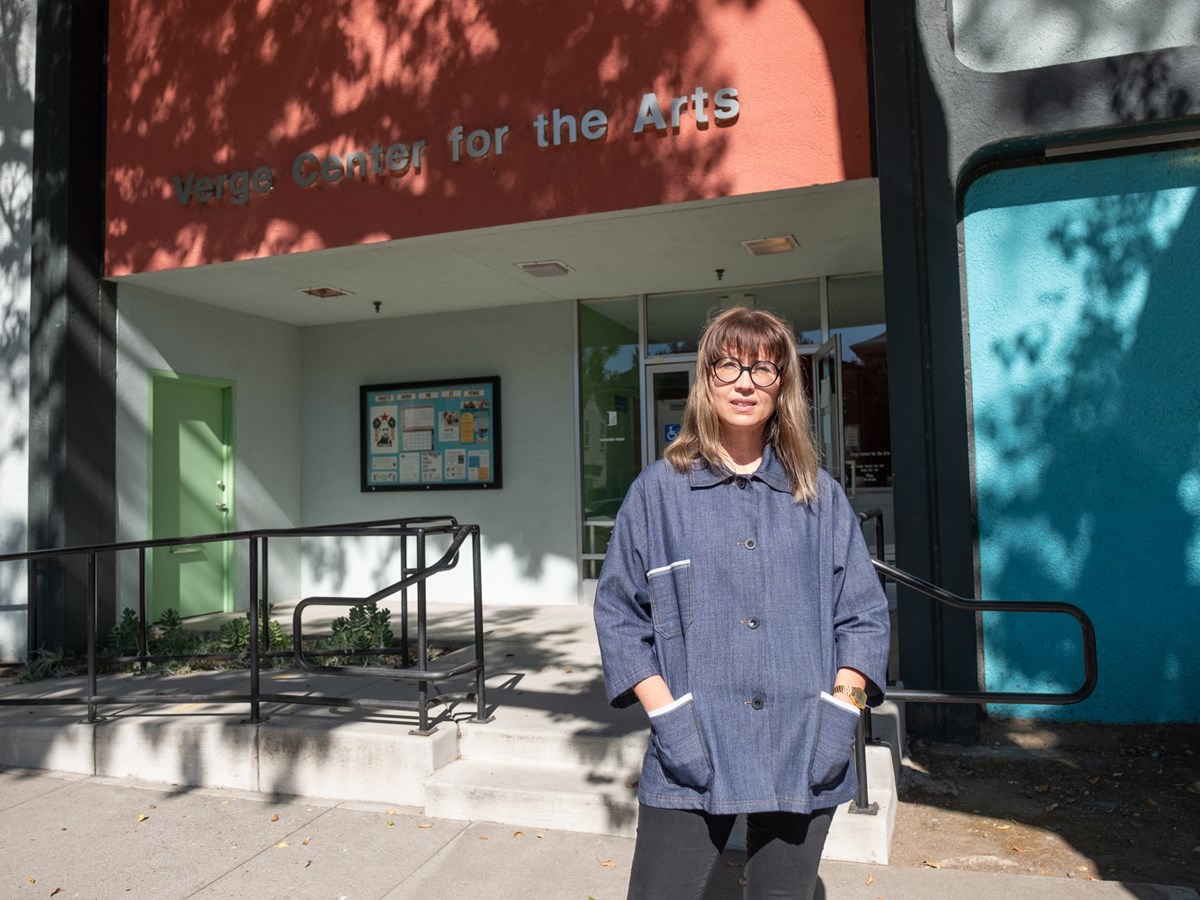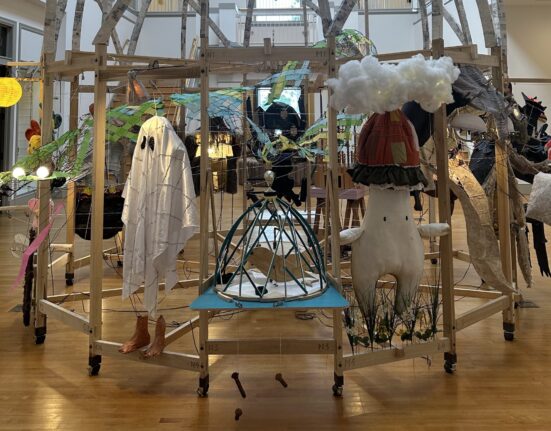Filipina-American textile artist Esther Marie Hall was thrilled when she was first accepted to the regional residency program at Verge Center for the Arts, a Sacramento-based contemporary arts nonprofit, in 2022.
“I thought it was this very high-up institution that I would never be able to participate in,” said Hall.
But her initial excitement gave way to trepidation during her tenure at Verge, where she felt unseen, unheard, and unsupported. Ultimately, she and another artist were evicted from their space, they say for raising questions about how the nonprofit was run, something leadership at Verge disputes.
“All I wanted was to make the space better,” said Hall tearfully about her understanding of the eviction. “You’re losing your livelihood over what could be remediated through a simple conversation — What is lacking here? What can we possibly do to make your experience a little bit easier?”
Hall is just one of many artists of color in Sacramento who have been compelled to share their stories interacting with Verge, an institution that has been in Sacramento for over a decade.
 Esther Marie Hall in her space at Verge Center for the Arts. Hall was evicted in March.Courtesy of Ester Marie Hall
Esther Marie Hall in her space at Verge Center for the Arts. Hall was evicted in March.Courtesy of Ester Marie Hall
Situated at the intersection of S and 7th streets, Verge Center for the Arts prides itself on “recognizing the historic national framework of systemic discrimination.” However, the eviction of the two resident artists of color, Latinx visual artist Daniel Alejandro Trejo and Hall, prompted criticism from past staff, residents, and community members about Verge’s treatment of minority creators.
Liv Moe, executive director of Verge, and her board say that the cause for the eviction has been investigated and is backed by video footage. Verge was asked to provide documentation or contacts of impacted staff, but they declined.
Moe has grappled with the online flurry of comments and said they have placed Verge in a precarious position.
“Maybe consider what it means to remove a resource from a community and if that kind of total destruction fits that punishment because it’s not just punishing Verge, it’s punishing every single person that Verge serves,” said Moe. “It’s been heartbreaking to watch that component of it.”
What initially appeared as an isolated incident sparked a moment of reflection for Sacramento’s art scene, magnified by a recent outcry from artists of color about the local organization Wide Open Walls for overlooking Asian artists in their Lunar New Year and Tết mural. The insufficient focus on diversity at Wide Open Walls, coupled with former Verge staff and artists detailing their unfavorable encounters, has led to apprehensions regarding Sacramento’s primarily white art scene.
Sacramento’s artists of color acknowledge that while Verge has endeavored to be accessible, progress has been stunted at diverse recruitment. Collectively, they underscore the importance of integrating culturally reflective leadership and trauma-informed practices in the workplace within Sacramento’s art institutions, especially when hiring and retaining people of color.
Hope and disappointment
Moe corroborated that a Verge staff meeting in January, where Trejo and Hall asked for transparency around Verge’s financial practices and other issues with how the nonprofit was run, contributed to the decision to evict Trejo and Hall. She would not comment on the eviction but said that clarity on the residents’ eviction could be found in the eviction letter.
The eviction letter sent on March 15, stated, in part:
“Clearly, you are not happy with the way the Project is designed, administered, and operated. You have publicly maligned VERGE, its staff, its Board, and other artists participating in the Project. As you are well aware, some of this was done while you remained on VERGE property and were subject to video and audio recording of your conduct.”
Distressed and confused, Hall and Trejo contacted one another to check in, soon realizing they were in a similar circumstance — dispossessed of their affordable art space and without a means to their creative pursuits.
Trejo had been commuting from Stockton to Sacramento for seven years to access subsidized studio space, while Hall struggled with job and housing instability and relied on the studio space for her career as an artist. The stress of relocating years’ worth of tools and artwork was heightened by the anxiety commonly felt by communities of color without alternative support systems.
Trejo, who felt that the studios at Verge were not being distributed to the arts community equitably, said he wanted his misgivings to be met with more action and empathy.
“I cried immediately,” he said about being evicted. “I think my biggest mistake was trying to diversify from within. When you’re privileged enough to be in a space like that, that’s when you think about empowering community.”
The relationship between artists of color, Moe and Verge wasn’t always this fraught. Hopeful artists said they joined the region’s emerging contemporary art space believing in its mission and inclusive messaging.
“I have a picture on Instagram where … I’m hugging the wall,” said Trejo about his first time acquiring studio space in 2017.
Hall paid it forward by recommending the same residency program that year to a fellow Filipinx nonbinary film and fiber artist, Jamie Pesquiza Cardenas.
“I was just so excited.” Cardenas added. “A Filipino from Valley Hi neighborhood doing an artist residency — like what?”
Their cultural art form involved working with an indigo dyeing vat, which Cardenas said they were forced to put in the back alley behind a gate at Verge, making it inaccessible for them with their disability.
And when holding a dyeing workshop in honor of Filipino History Month in October, Cardenas requested the classroom space, which was approved. But on the day of the event, the space was provided to a private class.
“Here we are working in the cold, watching a private class in the classroom,” said Cardenas. “I was almost in tears.”
 Participants pose in the Verge Center for the Arts parking lot after an October indigo dyeing workshop.Courtesy of the artists
Participants pose in the Verge Center for the Arts parking lot after an October indigo dyeing workshop.Courtesy of the artistsThe absence of communication and accommodations for their disabilities, combined with fighting for reliable paychecks, left them feeling powerless, they said.
“I sit on a number of these intersections: I’m disabled. I’m queer. I’m Filipinx. I’m a daughter of an immigrant,” advocated Cardenas. “There’s so much here and you’re failing at listening to my story as the person of power in these institutions.”
For Mexican paper-mache and visual artist Ramona Garcia, it was Verge’s Ali Youssefi Project — a residency aimed at “underrepresented perspectives” in art — that brought her to the space in 2022.
“I was really excited about finding community and being able to ground my practice in my city,” she said.
The cheap studio spaces at Verge kept her at the building for two years, but the income insecurity that underprivileged artists of color can encounter, compounded by what she said was a lack of communication from Moe, ended in an untimely exit from the space a month before Trejo and Hall’s eviction.
“I never really found I was valued in that space outside of that residency,” Garcia said about her interactions with Moe and leadership at Verge. “It expanded into my experience of not feeling seen.”
Garcia, Cardenas, Hall, Trejo all say that a shared narrative emerged: they often found themselves shouldering the responsibility of promoting culturally responsive practices and experiencing isolation from Verge management, who may go months without acknowledging their efforts. They felt tokenized for grant funding, Instagram posts, and cultural holidays, but devoid of respect internally at the organization.
Moe said Verge made an effort to support ideas from artists whenever possible.
“For the most part if there’s something that we can facilitate, we make it happen,” Moe said. “People will present us with ideas for programs. They suggest different communities that they think we should reach out to — I’m supportive.”
Aida Lizalde, a nonbinary Mexican multidisciplinary artist who rejoined Verge in 2019 as their education manager, had wanted to revolutionize conventions at the organization.
“When I started working at Verge, I was excited because there were just so many artists … and I had a lot of goals on how to promote diversity,” they said.
As time went on, Lizalde noted their discomfort with payment protocols at Verge for artists they were recruiting. Artists were being paid a percentage based on the number of people signing up for their workshops.
“I tried to advocate for artists getting paid by the time they were teaching plus a couple of hours of prep work,” said Lizalde. “But that was shut down.”
Still, in an attempt to diversify Verge’s staff, Lizalde hired Anna Morales, a Mexican-American ceramicist, to teach ceramics classes and run their Clay Lab.
“Verge is so unique. I really loved being there. It gave me a place to be and do my art,” said Morales. ‘“But it had this ugly side to it and you just had to put up with it.”
Her experience included complications with her wages, which seemed to contract with Verge’s decreasing cash flow: The nonprofit was in a deficit of $67,178 in 2019, and by 2022, Verge was in a $91,920 budget deficit.
“There’s this ongoing idea that there’s just a mountain of resources here, but running an arts organization is a razor’s edge endeavor,” said Moe. “You’re losing sleep at least once a month trying to figure out how to keep all the plates spinning.”
Accounts from Verge’s residents and staff of color, such as Morales and Lizalde — who both left in 2020 after feeling overworked, underpaid and their demands unmet — paint a picture where they say the organization’s guiding principles of “setting living wages for staff” were not upheld.
Fostering inclusivity within Verge
Morales’ departure left the education associate position open for a rotating group of artists. In 2022, emerging Filipina fabricator, printmaker and ceramicist Julie Bernadeth Crumb took the role.
Crumb said Verge facilitated positive interactions through Hall, Trejo and other artists, but was also present for negative interactions at Verge. She recalled when Cardenas’ cultural workshop was hosted outside of the classroom on a cold October day.
“I felt so uncomfortable knowing that this indigo workshop, which has deep cultural significance to the resident artist and the Filipino population, was quite literally pushed outside to make room for this private wheel-throwing class,” she said.
Her exit from Verge was prompted by witnessing Cardenas’ treatment, Crumb explained, and opened her eyes to racial insensitivity at white-led arts institutions in Sacramento.
“I felt they weren’t accommodating to people who looked like me,” said Crumb. “Verge was using black and brown bodies to promote the organization.”
Similarly, current Verge studio resident Ren Allathkani, a Palestinian multimedia artist, said Trejo and Hall were instrumental in her positive experiences at Verge.
Allathkani recalls Hall’s kindness during the attacks on Palestine and Gaza last year: “I was very depressed about everything going on in Gaza and I got to my studio and I find a little package with a handmade beanie.”
And Trejo helped her navigate Sacramento’s art landscape, which was new to her: “He’s very protective over emerging artists because he knows that they’re easily manipulated. If he didn’t tell me certain things, I would have been taken advantage of.”
 Artist Daniel Alejandro Trejo.Courtesy of Daniel Alejandro Trejo
Artist Daniel Alejandro Trejo.Courtesy of Daniel Alejandro TrejoFor Garcia, reconciling the loss Hall and Trejo’s regular companionship was nearly as discomposing as the loss of her art studio, which she could no longer afford.
“I had second thoughts of not leaving because of Esther and Daniel. They took it upon themselves to create a sense of community,” said Garcia. “They’d do gatherings, bring food and invited everyone.”
Before leaving, Morales also found kinship with Trejo, who helped her with tasks around Verge and uplifted her during a difficult time.
“He doesn’t come from money — we don’t come from money,” said Morales on Trejo’s eviction. “Why would he jeopardize [the studio]?”
She inevitably alludes to the underpinnings of the minority mindset and why people of color can be silenced: “There could be repercussions and because it’s just so ingrained — we couldn’t even speak our own language for so long.”
Hall, Trejo, and others echo that Moe and Verge act as gatekeepers to Sacramento’s arts opportunities, and it can prevent artists of color from speaking up.
Processing trauma can be time-intensive, suggested Lizalde, and even more difficult to confront.
“Norms of polite politeness get used in institutions to silence and to control people of color,” they advocated. “It is really normal for somebody who has been overworked, who hasn’t been listened to, who can’t afford to pay rent to act frustrated.
These transgressions are then flipped on people of color for being disruptive and dangerous, described Lizalde, addressing the cyclical nature of control in predominantly white spaces.
For Allathkani, reactions from people of color can be based in generational trauma and the consequences can outweigh having a voice.
“I think it’s hard for people to speak up and say what they’re feeling when there seems to be legal ramifications for it,” she said.
Verge as a case study
In the U.S., the arts have historically been segregated, and relegated to individuals from higher-income backgrounds and of white ethnicity. A study conducted in 2019 revealed that 85% of the art collected in US museums originated from white creators, a trend likely shaped by the predominance of white individuals in leadership roles at art institutions, which stands at 73% nationally.
Though similar data is not available regionally, Sacramento’s artists of color convey feeling like outsiders, scrounging for arts opportunities locally.
“Once I started kind of going to events [at Verge], I would look around at the crowd and be like — this is not a place for me or that supports me because events are predominantly white,” explained Hall. “The price point for their workshops and some of the events are extremely expensive and that’s not equitable or inclusive.”
Yet, Moe said Verge continues to be committed to the mission of diversity, equity, inclusion, and accessibility.
“When you look at our exhibition record in the last 14 years, the majority of Verge’s exhibitions have been marginalized groups, specifically people of color, members of the queer community and women,” reminded Moe.
 Liv Moe, Executive Director. Verge Center for the Arts pictured Wednesday, Oct. 21, 2020.Andrew Nixon / CapRadio
Liv Moe, Executive Director. Verge Center for the Arts pictured Wednesday, Oct. 21, 2020.Andrew Nixon / CapRadio
According to Verge, 64% of their 33 exhibitions have featured artists of color, and their staff is 46% people of color. For Moe, “maintaining panels that are diverse” is crucial to the diversity of their exhibitions because it “makes a huge difference in terms of the artists that get accepted into the program.”
Despite Verge’s efforts to recruit diverse residents and staff, the ethnic breakdown of their leadership tracks with the national trend.
Their board is 79% white and 72% of their artists in residence white — a number that does not reflect the city’s 60% majority-minority demographics.
Moe was specifically called into question by Black art critic and curator Faith McKinnie, who worked with Moe on the ‘Coordinates ICE PAC’ art installation and wrote an institutional critique on how race is a factor in an artist’s treatment at predominantly white-led organizations like Verge after the evictions.
“Artists would come to me and say they didn’t feel comfortable with her,” said McKinnie. “Most of those folks have happened to be people of color.”
Moe and Verge filed a petition for a temporary workplace restraining order on March 25 against McKinnie because of actions McKinnie took against staff when helping Trejo move his belongings after the eviction.
“I was put in a position in the days that followed the weekend of March 16th that involved having to ensure that our staff felt safe being in the building and coming to work and that the artists feel safe being in their studios and continuing to make work,” Moe said. “We’re still unpacking the circumstances and figuring out the best way to balance the community within Verge and protecting them while also opening up a bigger dialogue.”
Over 100 people were listed to be protected from McKinnie, though some teaching artists like Natasha Newman, and some resident artists like Allathkani, had not given their consent to be listed.
Newman, a nonbinary Black ceramicist, withdrew from teaching a workshop at Verge after they heard Hall’s story and was taken aback to see themselves listed on the formal restraining order.
“It makes no sense to me. I need no protection from Faith,” said Newman. “I feel like the biggest point of access into Sacramento’s art scene for me has been because of Faith.”
The restraining order was dropped when Verge opted to stop pursuing it before the hearing on April 19.
“What started with two artists saying, ‘Hey what happened with the money,’ then ends in being evicted and turns into a critique post by me which turns into [a restraining order],” said McKinnie. “My biggest thing is for the community to understand this is not okay … [art] institutions are here for us to engage and engagement is not always positive.”
This is not the first time that Verge has exercised their legal weight against their employees. Aside from the eviction and the restraining order, in a January memo, Verge also threatened their studio artists with legal action for slander when interrogated on the lawsuit filed against them by former board member and Verge founder Jesse Powell.
Hall, Trejo, and McKinnie expressed that the legal action taken against them has been time-consuming, financially draining, and emotionally traumatic.
Ex-staff and residents of color flagged other inconsistencies with Verge’s internal protocols: lack of transparency on studio rental scales for artists, diversity in access to the artist studios, shifting contracts and payment plans, and the absence of an HR department.
“I often had questions about how their waitlists worked,” said Garcia about the resident artist studios. “The pricing also seemed to change and it wasn’t about square footage.”
Moe refused to comment on the need for transparency or an HR department at Verge.
Artists look for ways to move forward
Chicano artist Raffa Chávez has been part of Sacramento’s evolving art community for over 30 years and stresses that Verge has been a vehicle for progress in arts representation.
“The reason I got involved with Verge was to open lanes for people from my vantage point,” he said. “That’s actually one of the only organizations that’s been open to a wide community.”
This moment of reckoning is an opportunity for growth, said Chávez, and that Verge is a rare space that shouldn’t have its doors closed.
But even he said that navigating white spaces requires concessions: “We’re not the owners of the galleries, so it’s easy to be overlooked.”
Maya Wallace, former Vice Chair of the Sacramento Metropolitan Arts Commission, has been championing arts contributors of color locally since 2016. A Black woman with a previous career in the arts, she has been closely involved in advancing representation within the Sacramento arts community.
We’re at a sort of inflection point where the next phase of this effort is to recognize and work alongside those artists on how they want to be supported and understanding that it’s not enough to be representative.
“We didn’t have a thing like Verge before we had Verge and Liv has been the person at the wheel. It’s hard not to honor that,” said Wallace on the expansion in accessibility to the arts that the nonprofit has aided.
Yet, the many pitfalls associated with increasing representation in white-led institutions were also occurring at Verge, she said, because they were not created by or for artists of color or queer artists.
“We’re at a sort of inflection point where the next phase of this effort is to recognize and work alongside those artists on how they want to be supported and understanding that it’s not enough to be representative,” said Wallace. “And that true inclusion is meeting people where they’re at and working together to co-create the future.”
Part of this effort, she found, requires trauma-informed practices embedded into the institution’s framework to bridge the fundamental understanding of what people of color go through compared to living the experience of a person of color.
“Sacramento’s arts institutions don’t have a practice of moving from a place of understanding,” she said. “I think we are missing why people are responding in the ways that they’re responding and are frustrated in the way that they are.”
Hall, Allathkani, and other artists of color’s call to action is not for Verge’s demise, but rather to see more arts spaces in Sacramento created by and for individuals like themselves — one where they do not have to put in as much personal labor to feel valued.
“This could be normalized — subsidized art spaces — especially one that is devoted to artists of color,” described Allathkani, finding it lonesome to be only one of the few people of color in arts spaces in Sacramento.
Thirteen former employees, including Lizalde, sent a letter to the board following the evictions, with requests they say would match Verge’s mission statement, and expressed faith in Verge as an arts institution.
The letter suggested hiring a new executive director, human resources team and applying term limits to board members.
“We understand that addressing these issues will take time,” the letter read. “We are not expecting an immediate solution. In the interim, we urge you to issue a public apology to the two artists who were evicted, as well as to the numerous staff members, artists, and community members who have endured discrimination, verbal abuse, mental distress, and other hardships due to Verge’s problematic leadership.”
The board has not yet responded to this letter, according to Lizalde.
“I see that there is a need to have broader dialogues around ways that Verge can be better,” admitted Moe.
On April 3, Verge released a statement that the organization has started integrating community feedback, including a pledge to include artist representation on their board of directors and a more robust scholarship program to enhance accessibility.
Correction: The previous version of this story incorrectly characterized the lawsuit against Verge by their former board member Jesse Powell. The article has been updated to show Jesse Powell is suing Verge.
Clarification: This story has been updated to clarify that Verge communicated their intent to stop pursuing the temporary workplace restraining order before the hearing on April 19.
Editor’s Note: This story was originally published on Friday, April 26, and removed the same day. The article was re-published on Tuesday, April 30 after editorial review.
Srishti Prabha is an education reporter and Report For America corps member in collaboration with CapRadio and The Sacramento Observer. Their focus is K-12 education in Sacramento’s Black communities.
CapRadio provides a trusted source of news because of you. As a nonprofit organization, donations from people like you sustain the journalism that allows us to discover stories that are important to our audience. If you believe in what we do and support our mission, please donate today.







